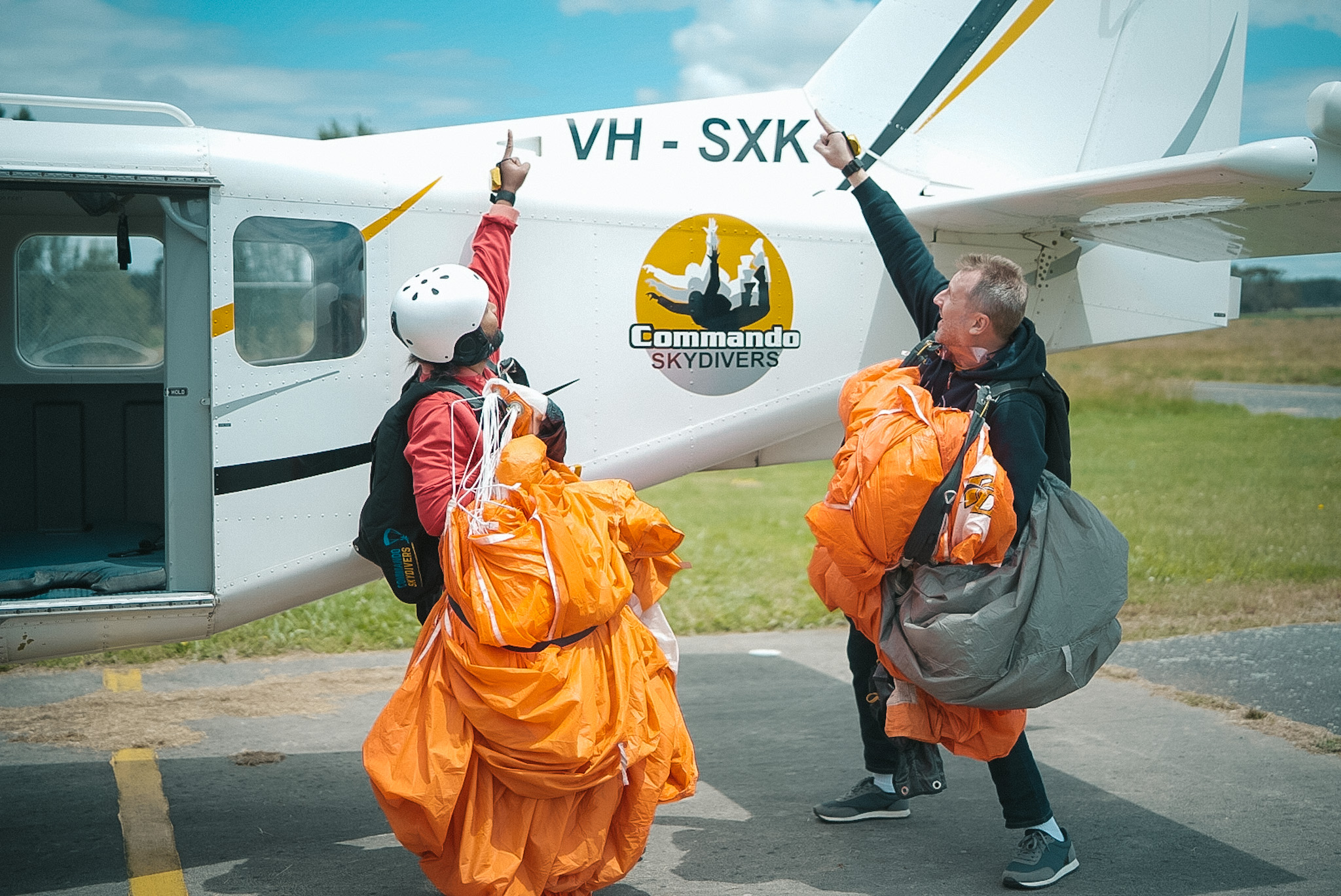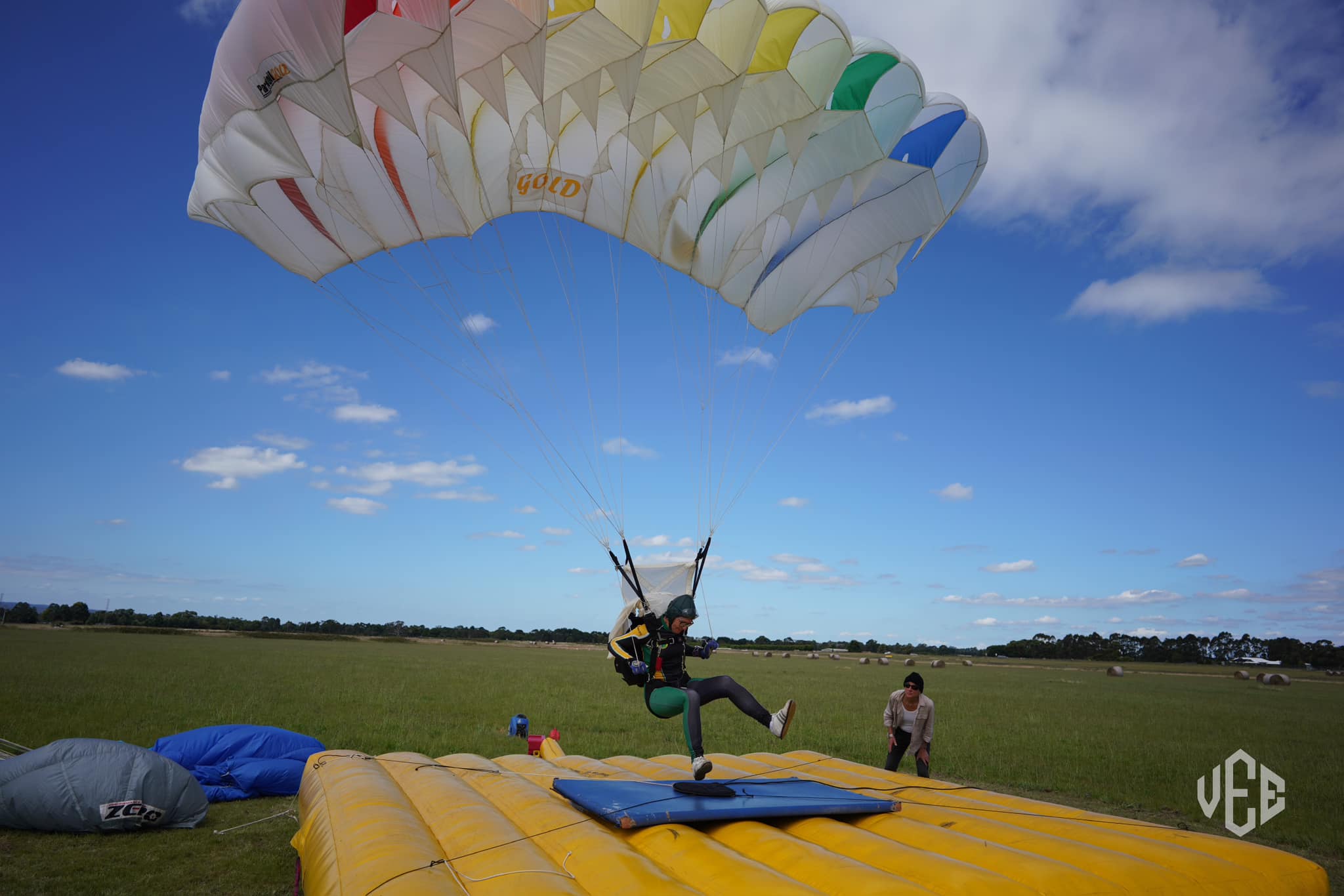FAQ
Most frequent questions and answers
Skydiving in Victoria
1. CLOTHING
We recommend comfortable loose clothing with fully enclosed shoes, such as running or sports trainers. Hiking boots and high heels are not appropriate.
2. GET A GOOD NIGHT’S SLEEP
Preparing for your first skydive is easy enough: in short, don’t do anything differently. Waking up and eating breakfast as you normally would is a good start.
3. REMEMBER TO BRING YOUR GLASSES
Or contact lenses, if you need them. All skydiving centres provide over-the-glasses goggles for skydivers, so you can thoroughly enjoy the views.
4. INVITE YOUR FRIENDS AND FAMILY
Skydiving is a spectator sport. Many skydiving centres have dedicated spectator viewing areas. Plus, get your friends to capture your landing for a great Instagram post.
All participants should be in good health and physical condition and should not be on medication which could affect judgment or performance. Before scheduling a jump, check with the drop zone’s weight requirements.
- After a short briefing you will be fitted into a harness.
- The plane ride will take between 20 to 30 minutes.
- Your instructor will connect you to the front of their parachute system before exiting the aircraft.
- Freefall can last up to one minute – the higher you go the longer the freefall!
- You can reach speeds over 200km/h towards the ground in freefall!
- Your Tandem Instructor opens the parachute and steers it to the landing area.
Weigh restrictions apply – consult drop zone for further details.
The minimum age requirement is 16 years old (with parental or guardian consent). There is no upper age limit – you’re never too old to jump from a plane!
Tandem Instructors working in Australia are all qualified and have a minimum of 500 skydives.
Absolutely – once you have done at least 100 skydives, hold a Certificate Class C and have received training on camera hazards that is. This is an APF rule and there are no exceptions. Our skydiving centre offer professional in-air videography by qualified instructors and camera flyers.
Sure! Here’s a rephrased version of your paragraph with a smoother flow while keeping the message clear and professional:
The cost of skydiving reflects the substantial investment required to maintain a safe, high-quality operation. While it may appear expensive at first glance, the profit margins are actually quite slim due to several key factors:
Aircraft-related expenses: including purchase or leasing costs, routine maintenance, insurance, and fuel.
Facility and infrastructure costs: such as hangar upkeep, land leases, and aerodrome operations.
Specialized equipment: top-tier gear that must be regularly inspected, maintained, and upgraded.
Expert staff: from instructors, ground crew, and pilots to riggers, engineers, customer service, and operations personnel — it takes a highly trained team to deliver a single jump.
So, when you consider everything that goes into making your experience safe and unforgettable — the thrill of freefall, the breathtaking views, and the guidance of a skilled professional — is the price really that high?
Upon arrival at the drop zone and check-in, you’ll be required to complete some paperwork. After that, you’ll be assigned an instructor and placed on a designated flight (load number). Your skydiving experience will follow this general timeline:
Safety briefing and gear-up: approximately 15 minutes
Flight to altitude: approximately 20 minutes
Freefall: around 60 seconds
Parachute flight: between 4 to 7 minutes
You’ll find detailed information in the product description and your booking confirmation email. The total duration of your skydiving experience can vary based on the location, your mode of transport, and weather conditions on the day. As a general guide, in ideal weather conditions:
Allow 1 to 3 hours for the full experience
While we strive to keep operations running smoothly, occasional delays can occur due to unforeseen circumstances. At Commando Skydivers, we prioritise safety above all else and operate with a leading safety and risk management system. Real-time flight departure boards at the drop zone keep you informed, and our staff will provide regular updates on timing or any delays.
If a delay is required to ensure your safety—whether it’s waiting on the ground or temporarily pausing operations—we won’t hesitate. Your wellbeing is our top priority, and we always aim to complete all skydives efficiently and safely.
Absolutely! Friends and family are more than welcome to join you before and after your skydive. Our drop zone is pet-friendly, with open spaces ideal for picnics and relaxing. However, for everyone’s safety and comfort, we kindly ask that all pets remain on a leash at all times.
At Commando Skydivers, safety is our highest priority. We uphold the highest standards through thorough training, state-of-the-art equipment, and strict compliance with industry best practices — all to ensure your skydiving experience is not only unforgettable but also as safe as possible.
Every skydiving rig is equipped with three essential safety components: a main parachute, a reserve parachute, and an Automatic Activation Device (AAD). In the rare event of a main parachute malfunction, your instructor will deploy the reserve. In the highly unlikely scenario that your instructor is incapacitated, the AAD is designed to automatically deploy the reserve parachute at a safe, pre-set altitude.
While parachute malfunctions are uncommon, safety is always our priority — which is why we have a built-in Plan B. Main parachutes are quick to repack, typically taking around 10 minutes. Reserve parachutes, however, require hours of meticulous inspection and repacking. At Commando Skydivers, we open, inspect, and repack every reserve parachute without exception.
At Commando Skydivers, we uphold rigorous standards that go well beyond the minimum requirements set by the Australian Parachute Federation. Our tandem instructors must complete a minimum of 800 to 1,000 skydives before they even begin their tandem instructor training.
Most of our team members have logged over 2,000 skydives and bring years of hands-on experience in conducting tandem jumps. This depth of expertise ensures that you’re in the care of highly trained professionals, committed to making your skydiving experience both safe and unforgettable.
At Commando Skydivers, all our equipment features the latest in skydiving technology. We have dedicated in-house riggers whose primary responsibility is to ensure the safety and reliability of our gear through regular inspections and timely reserve parachute repacks.
The same high standards apply to our aircraft. Maintained by our in-house engineering team, each plane undergoes frequent and thorough checks to ensure it meets or exceeds safety requirements. This commitment to ongoing maintenance allows us to deliver a consistently safe and reliable skydiving experience.
Yes, you can absolutely breathe while skydiving—and we strongly encourage it! The freefall typically lasts between 40 and 60 seconds, which is far too long to hold your breath.
If you ever feel like you can’t breathe during freefall, it’s likely because you’re unintentionally holding your breath. Just remember to relax and breathe in through your nose and out through your mouth. Once you settle into the sensation, you’ll find it’s easier than you might expect.
Skydiving is weather-dependent, and factors such as winds, clouds, and rain play a significant role in determining whether a skydive can take place safely.
Note: If weather conditions prevent the jump from happening, we will reschedule your skydiving experience to another suitable date and time at no additional cost.


